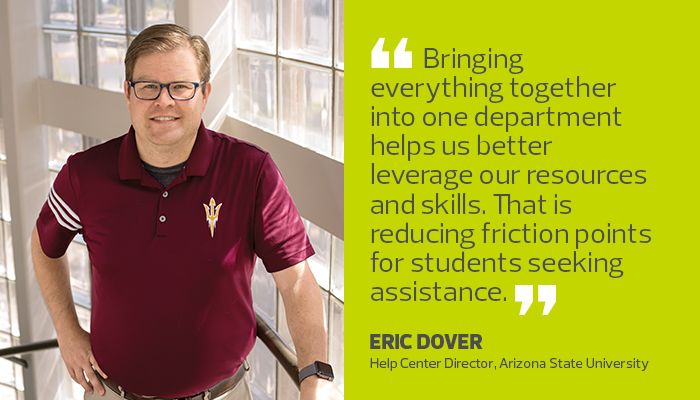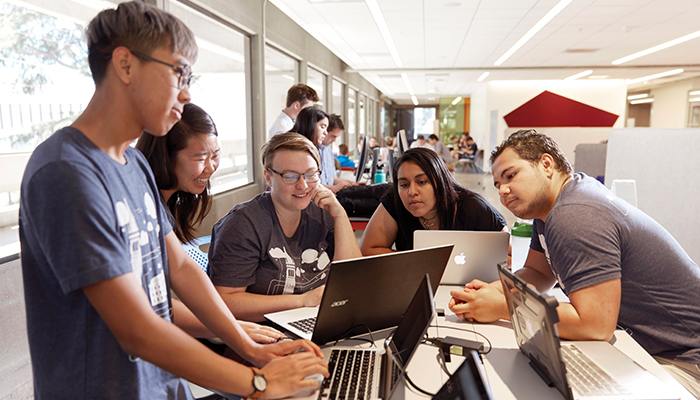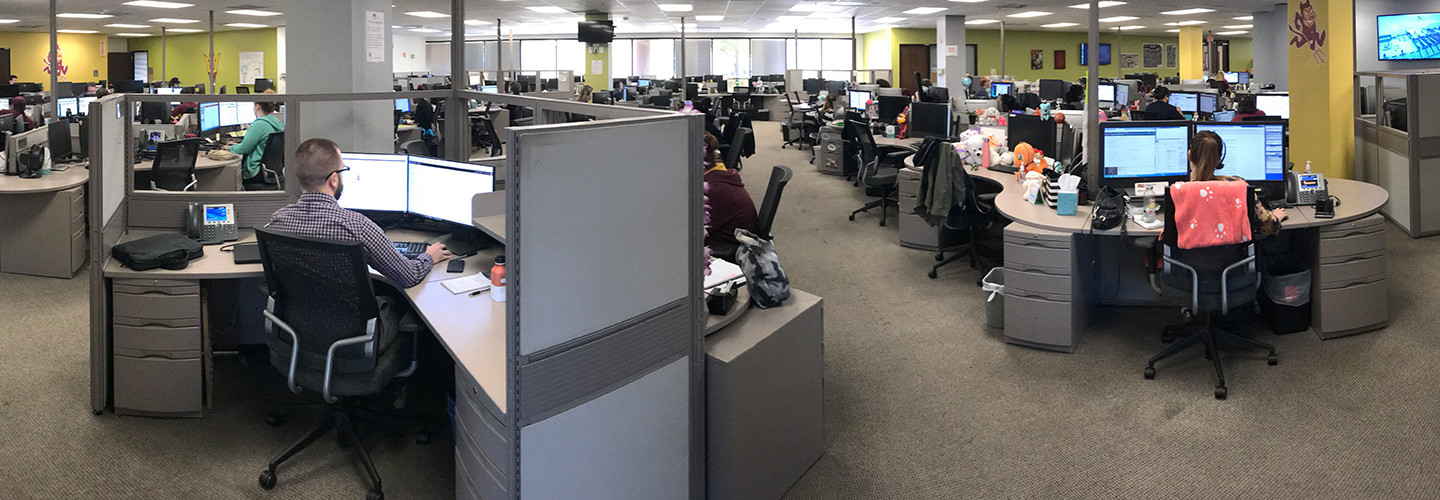Colleges Revamp the Help Desk to Streamline the Customer Service Experience
It might be alluring, especially when budgets are tight, to think that hiring students to work on the campus help desk will be a cost saver.
But Anne Marie Richard, director of student technologies at the University of California, Berkeley, cautions IT leaders not to view student-run IT resources only as a way to save money.
“Yes, it is cost-effective, but that can’t be what drives a move in this direction,” Richard says. “It has to come from a commitment to developing students as professionals and utilizing their expertise as student users.”
There are advantages, from a communications standpoint, to students collaborating with their peers to solve tech problems, she says. But more important still, working on UC Berkeley’s new campuswide help desk gives students a leg up when they pursue IT jobs after graduation.
The university’s administrators, seeing a professional development opportunity, designed the service to be run almost entirely by students, an approach that fits UC Berkeley’s tradition of student activism.

Anne Marie Richard is Director of Student Technologies at UC Berkeley, where students play a key role in help desk services. Photo by John Lee
“Once they graduate, these students have much more professional experience than people who only complete short-term internships,” Richard says. “Our student leads, in particular, come away with skills in HR and management, and they can demonstrate high levels of professionalism and autonomy. When they leave the campus, they often start in positions higher than entry level.”
Until 2016, tech support was available only to the relatively small percentage of students who lived in UC Berkeley’s residence halls. But the new campuswide program took inspiration from that grassroots initiative, which sprang up in dorms with the rise of the public internet.
Today, about 35 student tech consultants staff phone lines and drop-in support stations, while student leads serve as paraprofessional managers.
The Student Technology Services program recruits widely for support staff, reaching out to lower-income students who need on-campus jobs and to female, African-American and Latino students — groups underrepresented in the technology industry.
SIGN UP: Get more news from the EdTech newsletter in your inbox every two weeks!
Help Desks Shape Student Experiences
Help desks have come a long way from fielding questions about Wi-Fi passwords and software installation.
Fueling their evolution, in part, is the growing competition for students, which is leading institutions to rethink the role of help desks in the overall effort to deliver positive student experiences.
“Departments across universities are increasing customer service training,” says Heath Boice-Pardee, associate vice president for student affairs at the Rochester Institute of Technology. “They know that students expect higher levels of service because of all the competition out there.”
But enhancing customer satisfaction in IT support centers takes more than just a willingness to act. Help desk managers say colleges must also invest heavily in training and technology (think cloud-based collaboration suites) to turn a student’s problem into a student retention opportunity.
At Arizona State University, for example, today’s efficient, centralized service was born out of frustration. Until three years ago, ASU had outsourced the help desk, which led to routine complaints about poor service from students and faculty.
“I don’t think the vendors understood the scale and volume needed to support a higher education operation like Arizona State,” Deborah Whitten, assistant vice president for customer service and support, says.
In bringing the service in-house, ASU sought to address one of students’ biggest complaints: getting bounced around to various representatives for help with IT, financial aid and other concerns.
“Bringing everything together into one department helps us better leverage our resources and skills,” says ASU Help Center Director Eric Dover. “That is reducing friction points for students seeking assistance.”
ASU's Help Center Opens the Door to the University
ASU’s new and improved help center has 81 employees and 22 student reps who provide 24/7 service for 100,000 students (70,000 on campus and 30,000 online). Says Whitten: “We see the support center as a front door to the university. It’s for anyone from students and faculty to people who come for a ballgame and don’t know where to park.”
Now, when a rep solves a problem about an email login, for example, he or she asks if there’s anything else the caller needs to know. “Often, the response will be, ‘Well, I also have a question about parking,’ and we’re able to help with that too,” Dover says.
As such, ASU students expect the unexpected. But one recent call gave them pause: “How do I donate a dead body to the university?”

ASU's Chris Tyler, Antonio Miranda, Gigi Speaks, Eric Dover, Claud Archie and Jason Wiley help solve a variety of issues. Photo by Mark Lipczynski
The support rep didn’t immediately know how — or if — the university would accept a corpse for scientific study, but she knew how to find out.
“One of the beauties of our staff is that they’re really, really good at handling strange requests,” says Dover.
The rep contacted an expert from the College of Nursing and Health Innovation and learned there is, in fact, an area where cadavers can be donated for research. “We were able to quickly tell the caller what the options were,” Dover says.
University Service Success Supports the Community
So far, ASU’s results have been impressive. Reps handle a majority of incoming calls and chats in 30 seconds or less, and 95 percent of users say they’re satisfied with the service. Percentages like these are especially impressive given the volume of incoming questions: From September 2016 through August of this year, the help center fielded roughly 500,000 calls and more than 82,000 chats.
Now that ASU has a solid help desk in-house, it is partnering with city, county and state officials to create an emergency contact center capability that augments regional emergency management resources. Such initiatives have the potential to elevate campus help centers to a new role.
“The plan is that if there’s a disaster, such as a plane crash at the Phoenix airport, emergency management teams will be able to leverage our capabilities,” Dover says. “We’ll be able to quickly get information out to the public and concerned parents of students.”
Proactive Security Leads the Way
At Milwaukee Area Technical College, technology solutions enable the help desk team to be proactive in resolving problems. The help desk still provides traditional support for students and faculty, such as troubleshooting login problems with online courses, but the 12 paid employees don’t just wait for questions to come in. Instead, they monitor queues for emergency service tickets so they can resolve issues before they affect users.
That lets the team see, for example, if the IT department’s networking specialists have spotted a new malware infection on a firewall or server. “We’re the ones who go out and fix the infected equipment,” says Mike Williamson, director of help desk services and instructional media. Given the outbreak of ransomware and other exploits hitting college campuses, he says, “our focus on security has gotten tighter than ever.”

To serve MATC’s 37,000 full- and part-time students, the help desk uses Cisco’s Unified Communications Manager with integrated IP voice, messaging, video and mobile capabilities. MATC is migrating its legacy ticketing system to a cloud-based service management application that can assign levels of criticality to incoming requests for more effective triage. The platform will also let Williamson compare department performance to service-level agreements.
Tracking tools like these are valuable given the volume of phone calls hitting the help desk: Last year, staff handled 32,000 requests, including peak early-semester periods when daily numbers triple. “Throughout the year, our average queue time was 2 minutes, 18 seconds, which we’re proud of,” Williamson says. “I attribute that performance to having a very experienced staff.”
In-House Training Lets Colleges Tap All Students
To ensure speed and accuracy, many institutions also invest in extensive training. At ASU, new reps hone customer service skills and learn software applications, including a cloud-based interactive voice response telephony system from inContact. They then shadow experienced staff for a week before they start handling calls. Employees can take more instruction to become go-to experts in areas such as Duo, ASU’s two-factor authentication technology, or non-IT topics, such as financial aid or parking services.
At UC Berkeley, a comprehensive in-house training program makes it possible to recruit from a broad cross-section of students. “Even history majors with no tech support experience, for example, can become successful tech consultants,” Richard says.

UC Berkeley students Timothy Cruz, Elizabeth Fung, Jess Mankewitz, Ikram Magzoub and Mauricio Madrigal-Avina work on the help desk. Photo by John Lee
The university hires most new reps early in the spring to prepare them for fall assignments. Recruits learn how to troubleshoot devices and respond to the most common support questions. Two weeks before the fall semester, trainees undergo 40 hours of extensive instruction about operating systems, network devices, connection issues and escalation procedures.
“It’s pretty intense and led by both career and advanced student staff,” Richard says. “After that, they’re ready to go on the job.”








